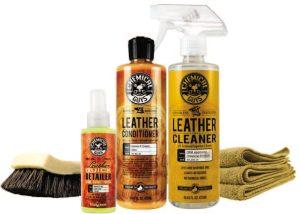 After a long day of work, most of us enjoy the simple pleasures of relaxing on the couch, putting our legs up, and watching TV. After just seconds of serenity, it can be ruined by your kids spilling something on the couch or your dog jumping up with muddy paws. Another perfect way to ruin your experience while sitting on the couch is finding dirt and grime when reaching for something that slipped between the cushions. Few of us often even consider what is under our cushions. Unwanted dirt will continue to make its way into your home every day, but there are steps you can take in cleaning your furniture to keep it looking newer for longer.
After a long day of work, most of us enjoy the simple pleasures of relaxing on the couch, putting our legs up, and watching TV. After just seconds of serenity, it can be ruined by your kids spilling something on the couch or your dog jumping up with muddy paws. Another perfect way to ruin your experience while sitting on the couch is finding dirt and grime when reaching for something that slipped between the cushions. Few of us often even consider what is under our cushions. Unwanted dirt will continue to make its way into your home every day, but there are steps you can take in cleaning your furniture to keep it looking newer for longer.
Before we begin, there are a few things to keep in mind. Read your manufacturer’s maintenance instructions that should have come with the sofa when you purchased it. If you decide to skip this step, it may result in your furniture being ruined or a void in your warranty. The type of material your couch is dictates what cleaning technique to use. If you lost or did not receive instructions during the purchase, then look for a tag on the furniture itself that states its cleaning instructions. When looking at the instructions or tag, there are letters that represent the type of cleaning your furniture prefers. “W” means you are able to clean your product with water; “S” means do not use water, purchase a special solvent-based cleaner; “WS” means you can use either water or a special solvent-based cleaner; and “X” means to vacuum only. Lastly, how often you clean your sofa depends on how often you utilize it. I recommend vacuuming upholstery and vacuuming or dusting leather couches once a week or every two weeks. For deep cleaning, I recommend every few months or when there is a stain. Keep an eye out to see if your couch needs some T.L.C. and clean it as you feel necessary.
 Regardless if it is dirt, food residue, or stains, these nuisances tarnish your furniture, shrinking your furniture’s life. Specifically, upholstered sofas are more prone to stains than leather sofas, as trapped grime can break down the cushion fibers. This will dull the appearance of your furniture causing you to get the least out of your investment. Next time you have a stain, check if your couch is marked with a “W” or “WS.” If so, then gather the following items: a vacuum cleaner with an upholstery attachment, at least three light-colored microfiber cloths that won’t bleed on your furniture, a bucket, distilled water, liquid dish soap, and distilled white vinegar. First, you should vacuum your couch with the upholstery attachment. Then, mix 2 cups of distilled water with 1 tablespoon of dishwasher liquid and 1 tablespoon of vinegar in the bucket. Spot test the solution on a small surface located in an unnoticeable part of the couch before applying it to the entire couch. If you see any discoloration after spot testing, then do not continue using the solution, and double check to see what ingredient isn’t supposed to be included. After you do this, dampen a microfiber cloth with the cleaning solution and gently blot any stained areas with the cloth. DO NOT rub or scrub, as this will only further damage the fibers. Next, moisten a fresh microfiber cloth with distilled water, and blot the area to remove the soap. Lastly, using a dry microfiber cloth, blot the area one more time to help absorb more of the solution. If you want to point a fan towards the area to dry it faster, that is also an option.
Regardless if it is dirt, food residue, or stains, these nuisances tarnish your furniture, shrinking your furniture’s life. Specifically, upholstered sofas are more prone to stains than leather sofas, as trapped grime can break down the cushion fibers. This will dull the appearance of your furniture causing you to get the least out of your investment. Next time you have a stain, check if your couch is marked with a “W” or “WS.” If so, then gather the following items: a vacuum cleaner with an upholstery attachment, at least three light-colored microfiber cloths that won’t bleed on your furniture, a bucket, distilled water, liquid dish soap, and distilled white vinegar. First, you should vacuum your couch with the upholstery attachment. Then, mix 2 cups of distilled water with 1 tablespoon of dishwasher liquid and 1 tablespoon of vinegar in the bucket. Spot test the solution on a small surface located in an unnoticeable part of the couch before applying it to the entire couch. If you see any discoloration after spot testing, then do not continue using the solution, and double check to see what ingredient isn’t supposed to be included. After you do this, dampen a microfiber cloth with the cleaning solution and gently blot any stained areas with the cloth. DO NOT rub or scrub, as this will only further damage the fibers. Next, moisten a fresh microfiber cloth with distilled water, and blot the area to remove the soap. Lastly, using a dry microfiber cloth, blot the area one more time to help absorb more of the solution. If you want to point a fan towards the area to dry it faster, that is also an option.
 Furthermore, steam cleaning may help when your entire couch is smelly or musty. It is recommended that you steam clean once or twice a year. To begin steam cleaning, look for a “W” or “WS” on your cleaning instructions. There are different settings on steam cleaners, so double check with the manufacturer’s instructions about which to use. Vacuum your sofa before steam cleaning, and vacuum it again once it’s dry. It may also be helpful to steam clean on a sunny day so you can open windows and air the room after you are finished. Also, remember to change the microfiber cloths that are in your steam cleaner; this way you will be able to pick up the most dirt each time. Lastly, wait until the water in the steamer is completely cooled before dumping it out. Other than that, you should be able to successfully steam clean your couch and get the best result.
Furthermore, steam cleaning may help when your entire couch is smelly or musty. It is recommended that you steam clean once or twice a year. To begin steam cleaning, look for a “W” or “WS” on your cleaning instructions. There are different settings on steam cleaners, so double check with the manufacturer’s instructions about which to use. Vacuum your sofa before steam cleaning, and vacuum it again once it’s dry. It may also be helpful to steam clean on a sunny day so you can open windows and air the room after you are finished. Also, remember to change the microfiber cloths that are in your steam cleaner; this way you will be able to pick up the most dirt each time. Lastly, wait until the water in the steamer is completely cooled before dumping it out. Other than that, you should be able to successfully steam clean your couch and get the best result.
If you are missing ingredients or an item from above, there are other options for you. Baking soda manages to always save the day. Sprinkle your cloth sofa with baking soda and leave it for 20 minutes; then vacuum the area. If you are still not happy after that, then mix the baking soda with dry carpet cleaner and leave it for another 20 minutes. Now, your freshly clean sofa should feel, look, and smell brand new!
 If you own a leather couch, then you are going to need to use a different cleaning process, but you are in luck because leather couches are much easier to maintain than cloth. The trick is to be quick once the spill has been made. I recommend using a leather cleaner and conditioner or purchasing a leather care kit. If you do not have leather cleaner, then grab mild soap and a damp cloth. After wiping your couch down, grab another damp cloth and remove the cleaner or soap. Dry the area and apply a protectant to condition the leather so future stains have a harder time staying on the surface. Also, I recommend placing your leather furniture out of direct sunlight. Daily sun exposure can wear down the color and crack the surface of your couch. Sharp objects, like your dog’s nails, are also likely going to crack or tear your leather couch over time, so be conscious about how often your pup jumps on the couch, or keep your couch covered.
If you own a leather couch, then you are going to need to use a different cleaning process, but you are in luck because leather couches are much easier to maintain than cloth. The trick is to be quick once the spill has been made. I recommend using a leather cleaner and conditioner or purchasing a leather care kit. If you do not have leather cleaner, then grab mild soap and a damp cloth. After wiping your couch down, grab another damp cloth and remove the cleaner or soap. Dry the area and apply a protectant to condition the leather so future stains have a harder time staying on the surface. Also, I recommend placing your leather furniture out of direct sunlight. Daily sun exposure can wear down the color and crack the surface of your couch. Sharp objects, like your dog’s nails, are also likely going to crack or tear your leather couch over time, so be conscious about how often your pup jumps on the couch, or keep your couch covered.
Whether you own a cloth or leather couch, it can be a struggle to keep your home presentable, clean, and stylish, especially with the amount of accidents we have every day. Make sure you read the maintenance manual before you start cleaning and call the furniture company if you have any questions. If upkeep seems too difficult or time consuming due to your fast-paced lifestyle or you do not want to clean your furniture yourself, then you can call a residential furniture cleaning business. If a furniture piece is beyond repair with just a cleaning, a professional restoration expert may be able to help. Soon you’ll be able to sit back and enjoy your newly clean furniture. ![]()
Rylee Copeland
Home & Yard Magazine




